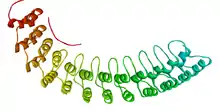Ankyrin
Ankyrine sind Repeat-Proteine, die wie Antikörper zu den Bindungsproteinen gehören. Ankyrine sind Cytoskelett-Proteine, die über dynamische, nicht-kovalente Bindungen mit integralen Membranproteinen interagieren und deren Verteilung innerhalb der Zellmembran mitbestimmen.

Die Struktur eines Teils der membranbindenden Struktur von Ankyrin
In Erythrozyten bindet Spektrin über Ankyrin an die Zellmembran.[1]
Die hereditäre Sphärozytose basiert in etwa der Hälfte der Fälle auf einer Deletion im Ankyrin-Gen.[2] Plasmodium falciparum bindet an Ankyrin.[3] ANK3 (Ankyrin G) ist möglicherweise an der Entstehung bipolarer Störungen beteiligt.[4]
Literatur
- Peter Michaely, Diana R. Tomchick, Mischa Machius, Richard G.W. Anderson: Crystal structure of a 12 ANK repeat stack from human ankyrinR. In: The EMBO Journal. 21, Nr. 23, 2002, S. 6387–6396, doi:10.1093/emboj/cdf651, PMID 12456646, PMC 136955 (freier Volltext).
- Vann Bennett, Anthony J. Baines: Spectrin and Ankyrin-Based Pathways: Metazoan Inventions for Integrating Cells Into Tissues. In: Physiological Reviews. 81, Nr. 3, 2001, S. 1353–1392, PMID 11427698.
- Patrick A Singleton, Lilly Y. W Bourguignon: CD44 interaction with ankyrin and IP3 receptor in lipid rafts promotes hyaluronan-mediated Ca2+ signaling leading to nitric oxide production and endothelial cell adhesion and proliferation. In: Experimental Cell Research. 295, Nr. 1, 2004, S. 102–118, doi:10.1016/j.yexcr.2003.12.025, PMID 15051494.
Einzelnachweise
- V. Bennett, P. J. Stenbuck: Identification and partial purification of ankyrin, the high affinity membrane attachment site for human erythrocyte spectrin. In: Journal of Biological Chemistry. 254, Nr. 7, 1979, S. 2533–2541, PMID 372182.
- Samuel E. Lux u. a.: Hereditary spherocytosis associated with deletion of human erythrocyte ankyrin gene on chromosome 8. In: Nature. 345, Nr. 6277, 1990, S. 736–739., doi:10.1038/345736a0, PMID 2141669.
- V. Bennett, P. J. Stenbuck: Identification and partial purification of ankyrin, the high affinity membrane attachment site for human erythrocyte spectrin. In: Journal of Biological Chemistry. 254, Nr. 7, 1979, S. 2533–2541, doi:10.1016/j.bbamem.2013.09.014, PMID 372182.
- Manuel A. R. Ferreira u. a.: Collaborative genome-wide association analysis supports a role for ANK3 and CACNA1C in bipolar disorder. In: Nature Genetics. 40, Nr. 9, 2008, S. 1056–1058, doi:10.1038/ng.209, PMID 18711365, PMC 2703780 (freier Volltext).
This article is issued from Wikipedia. The text is licensed under Creative Commons - Attribution - Sharealike. The authors of the article are listed here. Additional terms may apply for the media files, click on images to show image meta data.